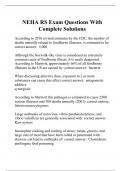Latin America 2024 Exam Questions
and Answers All Correct
What was the Cold War? - Answer-A post WWII rivalry between the US and the
communist USSR It was called "cold" because the two superpowers avoided direct war.
It was an important reason behind US actions in Latin America from 1945 to 1989.
Cuba, as a communist Latin American country, had an active role in the war and was
opposed by the US.
The Truman Doctrine and Greece and Turkey - Answer-The Communist People's
Liberation Army and the anticommunist forces supported by GB fought to control
Greece. Great Britain had to withdraw from Greece and turkey because of economic
problems. President Harry Truman of the USA was alarmed by the british weakness
and the possibility of soviet expansion into the eastern Mediterranean. He responded
with the Truman Doctrine: the United States would provide money/aid to countries that
were threatened by communist expansion. His thought was if the soviets were not
stopped in Greece, the US would have to face the spread of communism throughout the
free world.
The Marshal Plan - Answer-It was intended to rebuild prosperity and stability in post
WWII Europe. It included 13 billion dollars in US loans. These loans were also to
console the belief that Communist aggression fed off of economic turmoil. Soviets
thought that it was pathetic. In return, they thought, these countries would be exploited
by the US. Western Europe consented to the plan. The plan did not intend to shut out
either the Soviet Union or it's Eastern European satellites, but the union refused to
participate. The Soviet Union was in shape to fight with the US
COMECON - Answer-The Council of Mutual Assistance for the Economic Cooperation
of the Eastern European States. It was intended as a soviet version of the Marshal plan.
It failed because of inability of the Soviet Union to provide large amounts of financial aid.
The Policy of Containment - Answer-A policy formulated by George Kennan to keep
Communism within it's existing geographical boundaries and prevent further aggressive
soviet moves. After the soviet blockade of Berlin in 1948, containment on the Soviet
Union became a formal US policy. If you stop it from spreading it will eventually die out,
like a disease. The Domino Theory was the logical extension to the containment policy:
you have to work actively to contain communism because if one country falls to
communism neighboring countries are more likely to fall. This is one reason the US
became involved in Korea and Vietnam.
Arms race and mutual deterrence/MAD - Answer-The victory of the Chinese
Communists in the 1949 Chinese civil war created a new communist regime and
, strengthened US fears about the spread of communism. This same year the Soviets
exploded their first atomic bomb. Tension between the US and soviets led to an arms
race. This led to the building of even more destructive nuclear weapons and eventually
both had hydrogen bombs and intercontinental missiles (they could send nukes to any
world destination.) The search for security took the form of mutual deterrence, a policy
based on the belief that an arsenal of nuclear weapons prevented war by ensuring that
even if one nation launched it's nuclear weapons in a first strike, the other nation would
still be able to respond and devastate the attacker. "Mutually Assured Destruction"
would keep either side from risking the use of the massive supply of weapons that had
built up.
What were the struggles in Latin America before the Mexican War of Reform? - Answer-
Wars for independence resulted in a great loss of people, property, and livestock. New
nations went to war with each other to settle where their new boundaries were. Poor
roads, lack of railroads, thick jungle and mountains made communication,
transportation, and national unity difficult. There was also conflicts between the catholic
church's power and Latin America.
Mexico's war of Reform - Answer-It was an issue that started with a conflict between
church and state. The Catholic Church had enormous landholdings and exercised great
power over Latin America. Post independence, church officials often took new
government positions and wielded a lot of power. This created a division: liberals
wanted to restrict the powers of the church. Conservatives hoped to maintain all the
church's privileges. They fought and the conservatives won.
Were Caudillos good or bad? - Answer-Soon after independence, strong, wealthy
leaders called Caudillos came into power. They ruled by military force, they were
supported by landed elites. Many kept the new nationalized states together. Some were
modernizers who built roads, canals, and schools. Some were destructive, like Santa
Anna in Mexico, who misused state funds, halted reform, and created chaos and war.
Some were constructive supported by the masses, and served as instruments of human
change, like Juan Manuel de Rosas of Argentina, who favored Argentinian interests
against foreigners. In general Caudillos added to the instability of Latin America
because authority depended on their personal power, and when they died or lost power,
civil wars broke out for control.
Reasons for widespread poverty in Latin America - Answer-Latin America was ruled by
landed elites, and it's economy was based on farming, not industry. Large estates
remained a way of life, and land remained the basis of wealth, social prestige, and
political power throughout the 19th century. Landed elites ran governments, controlled
courts, kept a system of cheap labor. Land owners made large profits growing single
specialized crops for export. The masses, who were unable to have land and grow
basic crops, were therefore powerless and impoverished.
Latin American improvements after 1870 - Answer-Improvements were due to, in large
extent, the export of a few basic crops: wheat and beef from Argentina, coffee from





